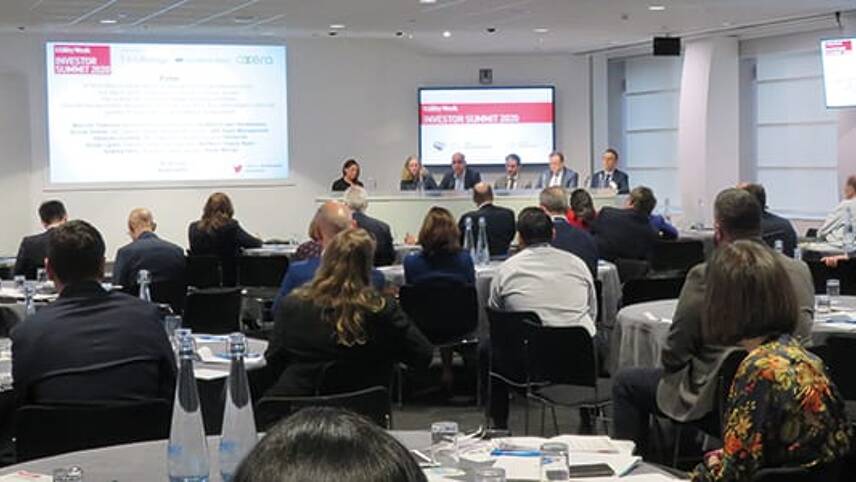You’ve reached your limit!
To continue enjoying Utility Week Innovate, brought to you in association with Utility Week Live or gain unlimited Utility Week site access choose the option that applies to you below:
Register to access Utility Week Innovate
- Get the latest insight on frontline business challenges
- Receive specialist sector newsletters to keep you informed
- Access our Utility Week Innovate content for free
- Join us in bringing collaborative innovation to life at Utility Week Live

Utility Week’s Investor Summit heard how climate change and legitimacy are reshaping investment models.
 The importance of the nation’s critical infrastructure and how to pay for it was already high on the agenda on the day the Investor Summit convened.
The importance of the nation’s critical infrastructure and how to pay for it was already high on the agenda on the day the Investor Summit convened.
With a Budget and National Infrastructure Strategy (NIS) due within days, utility leaders and investors were actively awaiting the new government’s spending plans and policies for addressing climate change, levelling up the country and the investment opportunities this would bring.
The release of the NIS has since been delayed and the wait continues, but there was agreement among both utilities and investors on the key areas that must be tackled to take the country and consumers forward, reassure investors and attract the levels of private financing that will be needed.
As chair of the National Infrastructure Commission, keynote speaker Sir John Armitt had a raft of hard-hitting messages to share, two years on from the publication of the government advisory body’s National Infrastructure Assessment in 2018.
He told delegates how the urgent need to decarbonise the economy and level-up all parts of the UK can be effected only by “asking the right questions” and “deciding on the exact outcomes”.
“Individual announcements from government without a cohesive long-term strategy creates a risk in terms of delivery, including attracting the private sector investment that is necessary to action them,” he said.
And this was not all about investment, he warned. “Consumers need to be positively brought along the journey. To do this, they need to see leadership.”
Regulators, too, had a key role to play in this, he said. “Good infrastructure supported by public and private investment requires the regulatory system to be effective and responsible to the evolving context.”
While “levelling-up cannot be done without digging up”, Sir John cautioned that investment in the regions cannot all be about “big shiny projects”. “Infrastructure alone is not going to level-up the rest of the country. City leaders outside London need new powers and adequate medium to long-term funding settlements.”
The session’s second speaker, the chief executive of Bristol Water, Mel Karam, highlighted the challenge of how utilities balance the requirements of the climate crisis with the requirement for investment and the issue of legitimacy and cost to consumers.
Parallels could be made with the past, he said, when water companies were born out of a need to radically improve public health and fulfil a social purpose. This aligning of companies, investors and public sentiment is extremely powerful, he added, pointing to how Bristol’s social contract has proved a mechanism that allows the company to understand and measure society’s and consumers’ understanding of the service they receive.
There were mixed responses from the investor panel discussion on the level and pace of government funding and the delivery of large infrastructure projects, although there was consensus on the positive view taken by investors on many aspects of the UK’s current regulatory models.
Capital was available and waiting, the summit heard, and a new majority government and decision on Brexit had all helped shore up confidence, but it also heard investors continued to look to government for clarity before moving on major investments.
Re-opening the contracts for difference auctions to onshore wind, solar and storage was wholeheartedly supported, as investor sentiment on fossil fuel divestment developed and interest rose in transition assets.
The rapid transformation of the utilities landscape was also seeing a shift in investor behaviour, with a move away from traditional investment models towards new models to diversify risks in single assets.
Suzanne Heneghan, editor, Utility Week magazine
Before coronavirus changed the world…
Jane Gray reviews discussion and debate on the interplay of regulation and legitimacy in the utilities sector from a time before coronavirus dominated.
In the days before the coronavirus outbreak transfixed the world and brought life as we know it to a halt, the Utility Week Investor Summit rallied company management and financial leaders alongside senior representatives from the investor, fund management and credit ratings community.
As one of the last physical events to take place before government advice saw a shutdown of conferences and other mass gatherings, the summit was still at liberty to foster discussion on non-pandemic issues, and the topics which dominated the day were undoubtedly the twin challenges of mitigating the impact of climate change and maintaining legitimacy for companies which are fundamentally connected to natural capital.
Two keynote speeches from the chairs of Ofwat and Ofgem set out how the industry’s regulators are attempting to absorb the complex issues tied up in these challenges into frameworks which create tough but investable market conditions for utilities – though responses in panel debates including representation from utilities chief executives and pension funds gave mixed reviews on their success.
While there was an overall message that institutional investors are willing to enter into a period of reduced returns on their utility investments as a necessary step in the battle for affordability and legitimacy, concerns were raised over how far returns should dip – especially in the context of rising demand for major infrastructure investment to support decarbonisation and climate resilience.
There was a clear message to regulators to be cautious of “throwing the baby out with the bath water” by altering regulatory frameworks with a good track record of attracting sustained private investment in an overzealous attempt to be seen as consumer champions.
One network chief executive candidly admitted he worries that Ofgem is trying to fix a model that is not broken in its proposed approach to the RIIO2 price control.
Other participants, meanwhile, questioned why both Ofwat and Ofgem seem unwilling to take more note of evidence that consumers are generally willing to pay more for their utilities if they can be confident this contribution will be used to combat climate change and promote resilience. Ofwat chairman Jonson Cox confidently knocked back these queries, saying there were no worthwhile resilience schemes put forward in PR19 business plans that did not receive funding.
That said, conference participants from both management and investor communities did not waste much time quibbling over regulated return rates or consumer bill contributions to fund the infrastructure investments and development of key technologies – such as hydrogen production and carbon capture and storage – which were universally acknowledged to be necessary within the coming decade and beyond in order to combat climate change.
Rather, discussion focused on the required shape of new flexibility mechanisms in upcoming price controls, the continued need for regulated innovation funding – for both the energy and water sectors – and the need for a significant rethink of the logic underpinning today’s wholesale energy market in order to unlock value in new service-based business models for a low or no carbon economy.
Another key debate issue was the growing role that local area planning and devolved climate change ambitions will have in stimulating low-carbon investment, and the importance of responding to this trend, especially for regionally based utility monopolies which must maintain legitimacy with the communities they serve.
Ofgem chair Martin Cave acknowledged this local dynamic to decarbonisation and the need to deliver for key stakeholders. But he also admitted Ofgem is “wrestling” with what all this should mean for its approach to RIIO2 settlements. “How do we react to those democratically elected mayors who have chosen to achieve more aggressive decarbonisation targets than the government?” he asked, pointing to the potential for regional inequality and consumer detriment if networks become focused on serving the needs of certain stakeholders over others.
Ultimately, discussion showed a keen awareness among management teams, investors, regulators and policy leaders of the importance of backing a new wave of massive investment in low-carbon infrastructure and technology demonstration projects. Any failure to be proactive on this would, it was agreed, endanger long-term returns for investors – with the potential for major social detriment where pension funds are concerned – and also create a legitimacy vacuum among companies which consumers expect to be environmental trailblazers.
There was some acceptance that this situation might mean taking the risk of stranded assets on the chin, and will certainly require patience from those investors waiting to benefit from business models based on smart home operations and flexible energy services. Where there was less agreement was on the extent to which this situation requires fundamentally new thinking around government incentives, a change of direction in taxation or the restructuring of markets.
These are areas of uncertainty that need urgent clarification if utilities are to fulfil their social purpose and pioneer the route to more a sustainable society. The key question now, though, is to what extent the unexpected and all-consuming distraction of the global coronavirus outbreak will derail the net zero roadmap, or in fact provide a timely recalibration of the available options and economic drivers for governments and markets to animate a dramatic low-carbon revolution in its wake.
Jane Gray, content director, Utility Week
Asking the right questions
Huge unknowns continue to loom over the future of the country’s national infrastructure but “asking the right questions” is critical, chair of the National Infrastructure Commission Sir John Armitt told Utility Week’s Investor Summit.
 The government may rightly have turned its attention to combatting the coronavirus, yet major infrastructure decisions still wait to be addressed.
The government may rightly have turned its attention to combatting the coronavirus, yet major infrastructure decisions still wait to be addressed.
Speaking before the outbreak redrew immediate national priorities, chair of the NIC, Sir John Armitt, said asking the right questions from the start was vital.
Armitt was also speaking shortly before news that the government’s National Infrastructure Strategy (NIS) would be further delayed. The commission therefore still awaits a formal response to its own National Infrastructure Assessment (NIA) from 2018 and Armitt’s hard-hitting message to the Investor Summit prevails.
On achieving change
“Defining the specific outcomes being sought when we approach major public infrastructure projects is absolutely key to building consensus, attracting investment and unlocking wider economic opportunity,” he said.
“All the areas we are discussing today… the urgent need to decarbonise our economy and the current political impetus behind levelling-up our economy… can only be fully effective if we spend some time deciding on the exact outcomes we want and the ways those outcomes can be achieved… Major infrastructure decisions need to be organised within a cross-departmental, cross-government, long-term strategy.”
Armitt outlined four key tests for the government’s NIS “to be worthy of the name”: a long-term perspective; clear goals and plans; firm funding commitments; and a genuine commitment to transformational change.
On the net zero imperative
The government has legislated for net zero since the NIA, accepted Armitt, but he added: “While the recommendations were set under a previous context, this further ambition underlines the urgency and importance of several of them, including delivering a highly renewable, flexible, 21st-century power system, with at least 50 per cent renewable generation by 2030.”
Pointing to a critical need for evidence trials for e-pumps and hydrogen heating to help deliver a net zero compatible heating solution, he warned: “I believe if those trials are not concluded and [do not] actually come up with some real conclusions in the next five or seven years at the latest, we have zero chance in reaching net zero by 2050.”
There was “a clear role” too for the regulatory framework to help electricity networks facilitate electric vehicle charging infrastructure.
But he told the City audience: “While net zero creates many challenges for utilities, importantly for investors it creates many opportunities. The Committee on Climate Change has estimated the target is expected to require £20 billion of investment a year in the power sector until 2050.”
On levelling up
Armitt welcomed the government’s clear ambition to drive employment opportunities and prosperity, across the North of England in particular, but cautioned it to look closely at what the communities themselves require.
City leaders need new powers and adequate funding settlements to unlock a potential myriad of urban projects supported by public and private funding. “But, crucially, they would be designed in the town hall rather than Whitehall.”
On regulation
“Good infrastructure, supported by public and private investment, requires the regulatory system to be effective and responsible to the evolving context,” said Armitt.
“Critically, we also recommend regulators should focus standard periodic price controls on the maintenance of existing networks.” It may be, he added, that “major strategic investment should be removed from that process and open to competition to support innovation”.
On legitimacy
Ensuring public trust in the regulatory system was “paramount”, he said. This benefits investors in a system with “high political and public confidence, and a lower risk of political intervention”.
“However, the price for this, and investors, is that building public confidence requires some rebalancing of where the risk is borne. I believe there are a huge number of politically rewarding opportunities for investors, but they should be prepared to accept a proportionate rate of return for low-risk infrastructure investments in the RAB [regulated asset base].
“Even when, especially when, there are tempting options available that might be politically expedient, or generate greater profit – with no corresponding benefit to the public – being willing to ask colleagues, clients or contractors the right questions to get to the core of the objectives behind the brief is the route for aligning customer, environment and financial priorities.”
The conversation
Calling for proper, grown-up public discourse on net zero, Armitt said: “Net zero is going to cost. Without a public understanding of that, it’s going to be very difficult for the regulator to achieve that balance.”
“Why I get excited, is that we have what I describe as our ‘man on the Moon challenge’. Except that we need 30 years; and 30 years is not a particularly long time in infrastructure terms. “
Suzanne Heneghan, editor, Utility Week magazine
Deal or no deal?
Now that the fog of nationalisation has lifted, M&A activity in the UK utilities sector may be unleashed but “a hangover” remains about the direction of travel.
This was the view of a panel of heavyweight investors who fielded questions at the summit.
The panel discussed the key questions investors are currently asking about UK utilities and how they weigh up the balance of risk and reward.
They were clear that regulated utilities in the UK are seen as ripe for deals, and that while investors have carefully watched the Brexit and nationalisation debates, the real levers are longer-term clarity on policy and regulation (it must be noted here that they were speaking before news of the coronavirus crisis broke).
Nourse pointed to huge swathes of opportunity in the energy transition and decarbonisation of heat processes, stressing the hunger for investors to be involved. But, he insisted a roadmap was needed from the government.
The panel also agreed that a decision needed to be taken on who would carry the risk for the massive investment needed to hit net zero emissions by 2050. If investors are expected to shoulder a lot of this burden, they can reasonably expect higher short-term returns.
Regulation will also have to be flexible to allow the funding of projects vital to achieving decarbonisation and freeing up innovation, they said.
The panel agreed that investors were willing to take a very long-term view of investments and that there was a discernable move towards lower or non-levered investments that allow investors a better view of the yield over the long term.
As new opportunities open up, investors are expecting much greater transparency on a number of issues. Antolik said the desire for direct investments came from that need to be close to the management teams and to understand the process. Lynch said more and more was being expected of the independent chairs of its various funds.
The issues being raised by investors range from environmental, social, and governance (ESG) to diversity and increasingly social contracts. However, they admitted that too often these were still “box-ticking” exercise and there was a lack of standardisation on how these impacts are measured.
Antolik summed up by saying: “You have to remember the UK is still very investable. It’s seen as one of the best countries in the world to invest in for infrastructure. There’s always a lot of noise in price control periods. When you step back from it, utilities offer a reasonable return for the risk you take.
“Investors will remain wary but deals will be done.”
James Wallin, editor, Utility Week digital
The panel: John Lynch, managing director principal investments at JP Morgan Infrastructure Investment Fund. The fund has around £15 billion under investment, of which 15 to 25 per cent at any one time is in the UK. Richard Nourse, former Merrill Lynch executive who founded renewable energy investor, Greencoat Capital in 2009. It now has £5 billion of assets. Peter Antolik, who has worked across the UK utilities sector and is now a partner at Arjun Infrastructure Partners, which invests directly in 12 different businesses at the moment, with a portfolio valued at £2 billion.
Expert view
Bronte Somes, UBS Asset Management
Key projects could be built with public money, then sold on
 Over recent decades, UK plc has facilitated material amounts of private sector capital for infrastructure investment delivering improved outcomes for consumers. Much of this capital has been mobilised through the government’s PFI/PPP model (funding over 700 projects) and economic regulation of water, energy and telecoms in the UK.
Over recent decades, UK plc has facilitated material amounts of private sector capital for infrastructure investment delivering improved outcomes for consumers. Much of this capital has been mobilised through the government’s PFI/PPP model (funding over 700 projects) and economic regulation of water, energy and telecoms in the UK.
In addition to PFI and economic regulation, UK plc has delivered large-scale infrastructure projects through bespoke models such as Channel Tunnel Rail Link, which became High-Speed 1 (HS1), and Thames Tideway Tunnel. In the March Budget, the government set out a £600 billion commitment to invest in infrastructure, including roads, broadband and electric vehicle charging over the next five years.
While the private sector’s involvement in this £600 billion is not clear, it highlights that the need for infrastructure investment is high. So how does the government “get Britain building”? One solution may be to take advantage of all-time low government borrowing and invest public funds in infrastructure. The infrastructure could be privatised once the asset is built in whole or part and a bankable revenue model overlaid making the asset investable by the private sector.
This model would allow risk to be allocated to the party best able to bear it until an asset can be invested in by the private sector. HS1 is a potential example. After several restructurings, the government successfully monetised a 30-year concession to own, operate and maintain HS1. For large economic assets, the government may not recover its investment, but the broader economic benefit should be taken into account, and once de-risked (in whole or part) the asset could be partially monetised for re-investment into other much-needed projects.
Bronte Somes, managing director, head of infrastructure equity Europe, Real Estate & Private Markets, UBS Asset Management
Expert view
Andrew Perry, Oliver Wyman
Stakeholders have got to constantly adapt
 In today’s evolving energy system, infrastructure investors are faced with an existential question about whether the space still presents the possibility for predictable investment. Roles that were once defined and distinct across the utility and oil and gas landscapes are now merging together, thanks to the introduction of new incumbents from across industries. And while opportunity and margin continue to exist, there remains a standing question about long-term certainty.
In today’s evolving energy system, infrastructure investors are faced with an existential question about whether the space still presents the possibility for predictable investment. Roles that were once defined and distinct across the utility and oil and gas landscapes are now merging together, thanks to the introduction of new incumbents from across industries. And while opportunity and margin continue to exist, there remains a standing question about long-term certainty.
Traditionally, infrastructure investors made predictions related to market dynamics and pricing over a 10 to 15-year period; today it is difficult to look beyond a two to three-year period without the involvement of subsidies or regulated returns. The current combination of technology, market, regulatory, and customer factors contribute to a changing competitive landscape, resulting in an array of possible outcomes for the sector.
Decarbonisation – specifically with regards net zero – is further localising the outlook for energy investment, as solutions are increasingly dependent on specific circumstances. For instance, real estate operators have an opportunity to develop solar on the rooftops of their commercial property portfolios at very low opportunity cost.
Likewise, energy solutions that meet specific business needs, such as EV charging stations, battery storage and decentralised generation, offer the opportunity to bundle contracted assets at good returns, but are hard to scale because they depend on local market and customer factors.
To thrive in this new landscape, investors need to incorporate commercial adaptability into their strategic planning. This involves not only remaining aware of current market dynamics and how they are changing, but also continuously evaluating their commercial model to adapt. Rather than rely on others to define the path forward, stakeholders – be they governments, regulators, investors, or businesses – need to continually iterate and evaluate trade-offs to succeed.
Andrew Perry, principal, Energy Practice, Oliver Wyman
Expert view
Malcolm Paterson, ScottishPower Renewables
The time to act on renewable infrastrucure is now
 As we enter the “decade of delivery”, the last ten years to implement the global goals agreed in Paris in 2015, time is of the essence. Net zero and its associated targets feature high on political agendas but what’s needed now is action.
As we enter the “decade of delivery”, the last ten years to implement the global goals agreed in Paris in 2015, time is of the essence. Net zero and its associated targets feature high on political agendas but what’s needed now is action.
At ScottishPower, we now generate 100 per cent green electricity after becoming the first integrated utility in the UK to shift completely from coal and gas to wind in 2018. And we have an ambitious pipeline of wind, solar and battery projects that will deliver investment, create jobs and power our lives in the most economical way possible. All while helping tackle a climate emergency.
There is no shortage of funding for large renewable projects, but investor confidence is driven by certainty coupled with a long-term plan that turns the ambition of achieving net zero into reality. A reality that the Committee on Climate Change suggests could see electricity demand double by 2050. With wind and solar forecast to provide over 50 per cent of supply, it is crucial the UK maintains a sustainable, competitive and secure energy model, regulated in a predictable and stable way.
The government’s consultation on the next contracts for difference allocation, which seeks to open it up for onshore wind and solar projects, is a welcome boost, and it’s also one of the first clear signs that government is serious about net zero by 2050.
If that commitment is to become a reality, we expect to see broader support from government to match it. An electric economy will require significant investment now in a smarter, more flexible network to support the growth of renewables and the time to act is now.
Malcolm Paterson, business development director, ScottishPower Renewables.
Expert view
Sahar Shamsi, Oxera
Legitimacy means balancing affordability and financeability
 The climate change agenda implies a dramatic increase in the investment needs of the regulated utility sectors. In the UK water sector, for example, the National Infrastructure Commission estimates that investment of about £930 million a year will be required; for the power sector as a whole, the expenditure requirement could be £20 billion a year to deliver net zero targets by 2050.
The climate change agenda implies a dramatic increase in the investment needs of the regulated utility sectors. In the UK water sector, for example, the National Infrastructure Commission estimates that investment of about £930 million a year will be required; for the power sector as a whole, the expenditure requirement could be £20 billion a year to deliver net zero targets by 2050.
Against this backdrop of significant investment needs, the notion of legitimacy in regulation appears to have taken on a life of its own, encompassing widespread public trust. One regulatory response to the legitimacy challenge is a higher level of risk aversion. It could be argued that this has manifested in recent regulatory price controls through lower allowed returns and a lower scope for outperformance, achieved via the use of various mechanisms. Mechanisms to reduce the scope for high-powered incentives or outperformance include, for example, indexation, volume drivers, lower sharing rates and return adjustment mechanisms.
A resultant concern is that if there is a lower scope for outperformance, a reduced profit impetus may disincentivise delivery of relatively high-risk and innovative net zero investments. For context, a 1 per cent movement in the allowed weighted average cost of capital presently implies an approximate £1.4 billion change in annual network returns, or about £1 per week for the regulated proportion of the average UK gas, water and electric household bills. A large movement in network returns therefore moves household bills slightly, which raises questions about whether this has a significant potential impact on legitimacy.
Looking beyond the present five-year controls, balancing concerns about affordability and financeability is imperative if long-term legitimacy is to be achieved. If companies are challenged in financing resilience and the energy transition, then that may itself induce a perception of illegitimacy, if the networks of tomorrow do not deliver what society then wants. A corresponding objective of the evolving regulatory model is to question whether the regime offers sufficiently high-powered incentives for private capital to undertake value-for-money investment in the real options today that create pathways for the net zero transition tomorrow.
Sahar Shamsi, CFA, Partner Oxera
Please login or Register to leave a comment.